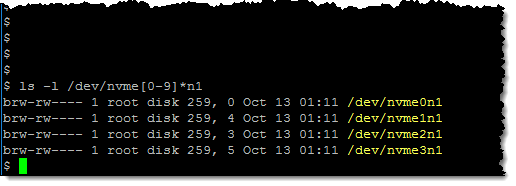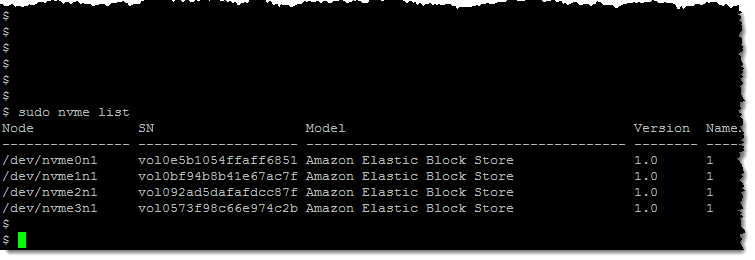AWS News Blog
Now Available – Compute-Intensive C5 Instances for Amazon EC2
I’m thrilled to announce that the new compute-intensive C5 instances are available today in six sizes for launch in three AWS regions!
These instances are designed for compute-heavy applications like batch processing, distributed analytics, high-performance computing (HPC), ad serving, highly scalable multiplayer gaming, and video encoding. The new instances offer a 25% price/performance improvement over the C4 instances, with over 50% for some workloads. They also have additional memory per vCPU, and (for code that can make use of the new AVX-512 instructions), twice the performance for vector and floating point workloads.
Over the years we have been working non-stop to provide our customers with the best possible networking, storage, and compute performance, with a long-term focus on offloading many types of work to dedicated hardware designed and built by AWS. The C5 instance type incorporates the latest generation of our hardware offloads, and also takes another big step forward with the addition of a new hypervisor that runs hand-in-glove with our hardware. The new hypervisor allows us to give you access to all of the processing power provided by the host hardware, while also making performance even more consistent and further raising the bar on security. We’ll be sharing many technical details about it at AWS re:Invent.
The New Instances
The C5 instances are available in six sizes:
| Instance Name | vCPUs
|
RAM
|
EBS Bandwidth | Network Bandwidth |
| c5.large | 2 | 4 GiB | Up to 2.25 Gbps | Up to 10 Gbps |
| c5.xlarge | 4 | 8 GiB | Up to 2.25 Gbps | Up to 10 Gbps |
| c5.2xlarge | 8 | 16 GiB | Up to 2.25 Gbps | Up to 10 Gbps |
| c5.4xlarge | 16 | 32 GiB | 2.25 Gbps | Up to 10 Gbps |
| c5.9xlarge | 36 | 72 GiB | 4.5 Gbps | 10 Gbps |
| c5.18xlarge | 72 | 144 GiB | 9 Gbps | 25 Gbps |
Each vCPU is a hardware hyperthread on a 3.0 GHz Intel Xeon Platinum 8000-series processor. This custom processor, optimized for EC2, allows you have full control over the C-states on the two largest sizes, allowing you to run a single core at up to 3.5 GHz using Intel Turbo Boost Technology.
As you can see from the table, the four smallest instance sizes offer substantially more EBS and network bandwidth than the previous generation of compute-intensive instances.
Because all networking and storage functionality is implemented in hardware, C5 instances require HVM AMIs that include drivers for the Elastic Network Adapter (ENA) and NVMe. The latest Amazon Linux, Microsoft Windows (Server 2008 R2, Server 2012, Server 2012 R2 and Server 2016), Ubuntu, RHEL, CentOS, SLES, Debian, and FreeBSD AMIs all support C5 instances. If you are doing machine learning inferencing, or other compute-intensive work, be sure to check out the most recent version of the Intel Math Kernel Library. It has been optimized for the Intel® Xeon® Platinum processor and has the potential to greatly accelerate your work.
In order to remain compatible with instances that use the Xen hypervisor, the device names for EBS volumes will continue to use the existing /dev/sd and /dev/xvd prefixes. The device name that you provide when you attach a volume to an instance is not used because the NVMe driver assigns its own device name (read Amazon EBS and NVMe to learn more):

The nvme command displays additional information about each volume (install it using sudo yum -y install nvme-cli if necessary):

The SN field in the output can be mapped to an EBS volume ID by inserting a “-” after the “vol” prefix (sadly, the NVMe SN field is not long enough to store the entire ID). Here’s a simple script that uses this information to create an EBS snapshot of each attached volume:
$ sudo nvme list | \
awk '/dev/ {print(gensub("vol", "vol-", 1, $2))}' | \
xargs -n 1 aws ec2 create-snapshot --volume-idWith a little more work (and a lot of testing), you could create a script that expands EBS volumes that are getting full.
Getting to C5
As I mentioned earlier, our effort to offload work to hardware accelerators has been underway for quite some time. Here’s a recap:
CC1 – Launched in 2010, the CC1 was designed to support scale-out HPC applications. It was the first EC2 instance to support 10 Gbps networking and one of the first to support HVM virtualization. The network fabric that we designed for the CC1 (based on our own switch hardware) has become the standard for all AWS data centers.
C3 – Launched in 2013, the C3 introduced Enhanced Networking and uses dedicated hardware accelerators to support the software defined network inside of each Virtual Private Cloud (VPC). Hardware virtualization removes the I/O stack from the hypervisor in favor of direct access by the guest OS, resulting in higher performance and reduced variability.
C4 – Launched in 2015, the C4 instances are EBS Optimized by default via a dedicated network connection, and also offload EBS processing (including CPU-intensive crypto operations for encrypted EBS volumes) to a hardware accelerator.
C5 – Launched today, the hypervisor that powers the C5 instances allow practically all of the resources of the host CPU to be devoted to customer instances. The ENA networking and the NVMe interface to EBS are both powered by hardware accelerators. The instances do not require (or support) the Xen paravirtual networking or block device drivers, both of which have been removed in order to increase efficiency.
Going forward, we’ll use this hypervisor to power other instance types and plan to share additional technical details in a set of AWS re:Invent sessions.
Launch a C5 Today
You can launch C5 instances today in the US East (N. Virginia), US West (Oregon), and Europe (Ireland) Regions in On-Demand and Spot form (Reserved Instances are also available), with additional Regions in the works.
Update (February 2018): When we launched the C5 instances last November we did not recommend them for use in conjunction with sc1 or st1 volumes. The underlying performance issue has since been addressed and the instances can now be used with both types of volumes.
— Jeff;